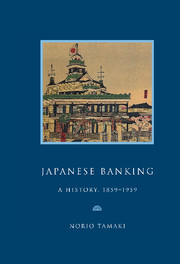Book contents
- Frontmatter
- Contents
- Preface
- Genealogy of leading Japanese banks, 1859–1959
- List of abbreviations
- Map
- Part I A bankrupt Shogunate, 1859–1868
- Historical background
- 1 Japanese merchant bankers: ryogae, 1859–1868
- 2 A bankrupt regime, 1859–1866
- 3 Ryogae struggling for survival, 1859–1868
- 4 The arrival of western banking, 1863–1868
- Part II The Meiji Restoration: monetary confusion and banking experiments, 1868–1881
- Part III Matsukata, the wizard of Japanese banking, 1881–1897; the Yokohama Specie Bank (1880) and the Bank of Japan (1882)
- Part IV The Japanese on the London money market, 1897–1911
- Part V War, the Japanese boom years, 1911–1919
- Part VI Crisis and the road to war, 1919–1937
- Part VII Complete commitment, struggle and defeat, 1937–1945
- Part VIII American ‘democratisation’ and the search for growth, 1945–1959
- An extraordinary century, 1859–1959
- Appendices
- Notes
- Bibliography
- Index
2 - A bankrupt regime, 1859–1866
Published online by Cambridge University Press: 03 February 2010
- Frontmatter
- Contents
- Preface
- Genealogy of leading Japanese banks, 1859–1959
- List of abbreviations
- Map
- Part I A bankrupt Shogunate, 1859–1868
- Historical background
- 1 Japanese merchant bankers: ryogae, 1859–1868
- 2 A bankrupt regime, 1859–1866
- 3 Ryogae struggling for survival, 1859–1868
- 4 The arrival of western banking, 1863–1868
- Part II The Meiji Restoration: monetary confusion and banking experiments, 1868–1881
- Part III Matsukata, the wizard of Japanese banking, 1881–1897; the Yokohama Specie Bank (1880) and the Bank of Japan (1882)
- Part IV The Japanese on the London money market, 1897–1911
- Part V War, the Japanese boom years, 1911–1919
- Part VI Crisis and the road to war, 1919–1937
- Part VII Complete commitment, struggle and defeat, 1937–1945
- Part VIII American ‘democratisation’ and the search for growth, 1945–1959
- An extraordinary century, 1859–1959
- Appendices
- Notes
- Bibliography
- Index
Summary
On 3 August 1858, a day before the proclamation of the successor to Iyesada, Shogun XIII, who was dying, a small, lightly armed British squadron under the command of James Bruce, Earl of Elgin and Kincardine, left Nagasaki for Edo. A Dutch consul resident in Deshima in Nagasaki had informed the Japanese that the British had bombarded South China Canton and were on their way to confront Japan, but it must be doubted that the bakufu, struggling for a way out of a grave political crisis, understood the implications of this information. What the Dutch consul really wished to convey was the fact that although the Americans had been the pioneers forcing their way into Japan, it was the British whom the Japanese had most to fear at that time. Even Lord Elgin, a modest man, would have been astonished and piqued to know that the bakufu government did not know who he was, or that he represented the then most powerful nation. The Japanese recognised that they had to negotiate to comply with his demands, that is all.
On 12 August 1858, Lord Elgin on board the Furious, ‘from which the main-deck guns had been removed’, penetrated deep into Edo bay, casting anchor off Shinagawa which was a mere four miles away from the seat of power at Edo castle. He was accompanied only by the Retribution and the Lee, together with a steam yacht – a gift for the Japanese Emperor. Elgin was supremely confident in himself and in the nation he represented and, without hesitation, he sailed north to the Bay of Tokyo.
- Type
- Chapter
- Information
- Japanese BankingA History, 1859–1959, pp. 10 - 12Publisher: Cambridge University PressPrint publication year: 1995



